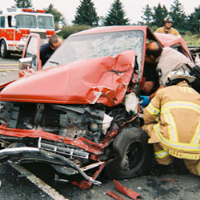Unlicensed Drivers Almost Three Times More Likely to Cause Fatal Crash . . . or, Maybe Not

Drivers with suspended licenses or none at all are nearly three times more likely to cause fatal accidents than lawful drivers in California, according to a study of fatal automobile crashes.
The findings were extrapolated to conclude that improperly credentialed drivers were “much more hazardous on the road” than licensed drivers and used to justify the study’s recommendation that the controversial practice of impounding vehicles of unlicensed drivers be continued as a countermeasure.
It is generally accepted that the overwhelming majority of unlicensed drivers in California are illegal immigrants, since the law has denied them licenses since 1994. Police sweeps at traffic checkpoints that result in impounded vehicles and the licensing of undocumented persons have long been part of the state’s immigration debate.
The study by Sukhvir S. Brar in the Department of Motor Vehicles Research and Development Branch, which analyzed data from 1987 through 2009, was constrained by methods for determining fault in accidents. Because a driver killed in a crash is rarely given a ticket posthumously by law enforcement, the study relied on post crash determinations by officers for assigning blame.
That and other criteria resulted in just 10% of all fatal crashes being considered in the study. A crash had to involve just two vehicles, only passenger cars or pickup trucks, one at-fault driver and one not-at-fault driver. Some crash data was thrown out because of missing variables in a record.
The study was seized upon by those with an anti-immigration bent as evidence that visitors from other countries pose a threat to the state’s safety and well-being. But one final potential limitation noted by the study’s author involves the documented “negative halo effect,” in which law enforcement officials are more likely to “judge a driver to be responsible for the crash if they were not validly licensed.”
The “negative halo effect” was cited by DMV researcher David DeYoung in the DMV’s last shot at analyzing the dangers of improperly credentialed drivers. The 1997 report, cited but virtually ignored by the new DMV report, argued that “there are serious problems in identifying and studying unlicensed drivers.” DeYoung opted to limit his study to just those with suspended or revoked licenses, because they are a known group of dangerous drivers.
DMV Research Manager Richard Hagge wrote in a 2010 email “we have no data on the make-up of the unlicensed driver population, the representation of undocumented drivers in that group, or the crash risk posed by undocumented drivers.”
Critics of studies that focus narrowly on fatal crashes as a way to generalize about driver safety note that the data set is tiny, the accidents disproportionately occur on highways at night and drinking is often involved.
Russell Trenholme, in a 2010 paper entitled The Questionable Foundation for the “Dangerous Unlicensed Driver” Stereotype, suggested a better way to study the relative risk of various categories of drivers would be examine the actual driving records of a few hundred randomly selected drivers in each category.
He concluded that the DMV had no interest in such a study because it might result in police losing “their principal justification for the massive impoundment of vehicles driven by undocumented immigrants.”
–Ken Broder
To Learn More:
Estimation of Fatal Crash Rates for Suspended/Revoked and Unlicensed Drivers in California (by Sukhvir S. Brar, Department of Motor Vehicles Research and Development Branch) (pdf)
The Questionable Foundation for the “Dangerous Unlicensed Driver” Stereotype (by Russell Trenholme) (pdf)
- Top Stories
- Controversies
- Where is the Money Going?
- California and the Nation
- Appointments and Resignations
- Unusual News
- Latest News
- California Forbids U.S. Immigration Agents from Pretending to be Police
- California Lawmakers Urged to Strip “Self-Dealing” Tax Board of Its Duties
- Big Oil’s Grip on California
- Santa Cruz Police See Homeland Security Betrayal in Use of Gang Roundup as Cover for Immigration Raid
- Oil Companies Face Deadline to Stop Polluting California Groundwater





